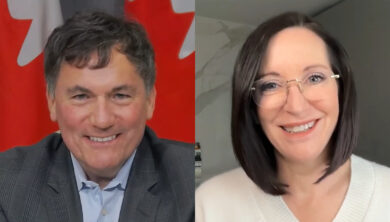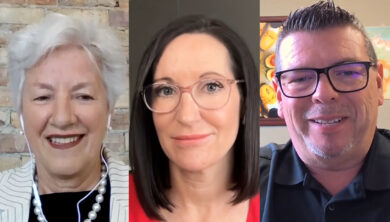
Rebuilding Canada Demands Confronting Uncertainty
by Jonathan Goodman and Paul BienAfter eight months of COVID-19, Canadians are tired. We are tired of restriction and fear, of distance from our loved ones and each other. Most of all, we are tired of uncertainty. But the virus doesn’t care. As The Economist noted: you may be tired of the pandemic, it has not tired of you.
This is our reality and our context, not just today, but well into the future. Even with a vaccine. Yet as tired as we are, we must remain vigilant and acknowledge that our pandemic fatigue doesn’t make the path from here any less uncertain. This is true for every Canadian, and especially our business and government leaders. And, it is certainly true when it comes to determining how best to rebuild Canada and re-invigorate our future prosperity.
But we must not turn away from uncertainty; we must confront it.
Doing this demands that our governments build uncertainty into their policy-making and program design. At the same time, our policy makers must convey empathy, trust and stamina. This will not be easy.
The Public Policy Forum’s Rebuild Canada series discusses how to make Canada even better in the future, and how to use the pandemic as a catalyst for doing so. The series offers encouragement and ideas on everything from how to enhance Canada’s competitiveness and share our prosperity more equally,[1] to tackling compounding deficits and strengthening our place on the world stage.
Our contention is simple: policy ideas must now be created and weighed through the lens of persistent uncertainty. This “uncertainty screen” will help ensure a vision of the future that reflects the uniquely complex environment we are in today.
Uncertainty is not a total stranger. But dismissing it because we are tired or complacent will only bring negative and lasting consequences. If anything, we believe that embracing uncertainty is how Canadians can solve some of the most chronic and long-standing issues our country faces.
Canadians today face deep uncertainties about health, the economy, and society, and across three different, but related, timeframes:
- In the near term (i.e., the next six to 12 months), no one really knows how COVID-19 progresses or how governments can effectively contain it. We don’t know what combination of guidelines, mandates, and lockdowns will work best and soonest. Will the public adhere to them? How effective and available will vaccines be? When will they arrive? How punishing will the near-term economic consequences be if broad containment measures need to be re-imposed?
- In the medium term (12-24 months), no one is certain about the nature and shape of Canada’s economic outlook, especially if a vaccine is not widely available. We might hope for a quick recovery, but need to be ready for prolonged pressure, and a sluggish, uneven re-set between sectors, regions, and citizens.
- Over the longer term (three to five years and beyond), Canadians must quickly come to terms with how the pandemic has fundamentally changed our lives, our expectations, and our future as a society. How will power structures, supply chains, and relationships reshape the global economic order?
These uncertainties and timeframes are sure to collide in both predictable and unexpected ways.
Unfortunately, human beings aren’t built to deal well with ambiguity – either individually or in groups. In fact, decision-makers generally respond to uncertainty in one of three ways:
- Deny its existence
- Acknowledge its existence, but become paralyzed by it
- Grow tired of it due to its constant and often punishing nature
It is vital to guard against these tendencies. Right now, policy-makers are at risk of growing tired of the situation, at the very point when leaders need to be most alive to it.
Because when people grow weary of uncertainty, they tend to distort history in order to cloak it in familiarity. This is already creeping into Canada’s economic discourse, as pundits and policy-makers apply recognizable letters or symbols to the recovery (including V, U, W, and now K). Using recognizable letters might make us feel better, but doing so brings us no closer to knowing the future.
The consequences of these responses are problematic for business leaders; for governments and policy makers they can be calamitous. Because, with such significant uncertainty, policy prescriptions can be mis-applied far too easily in either their target or their size. Policy instruments could be either too blunt or too narrow. Either of these circumstances creates the very real risk of policy responses having negative unintended consequences and/or taking the country in the wrong direction.
We believe governments and policy-makers must embrace uncertainty and make it a foundation of their decision-making. Doing so requires intellectual humility.[2] In other words, know what you know, know what you don’t or can’t know, and have the wisdom to know the difference.
This is about mindset. From it emerges five practical ways to exploit uncertainty and, by doing so, make better policy and program design decisions.
Implications for policy and program design today
1. Reflect on the uncertainties relevant to government’s policy agenda
This means considering the key uncertainties that are most relevant to your own areas of policy-making, right now, next year, and beyond.
This consideration is crucial when you begin to wrestle with the most relevant factors to your policy agenda, especially in a nation like ours where not every region, ministry, or agency faces the same uncertainties. It is important to twin the consideration of uncertainties with the most relevant available data,[3] but recognize that data can only tell us about what has happened, is happening, or could happen, not what will happen.
On the other hand, it’s unwise to use reductive thinking in order to oversimplify this most complex of situations. Rather, policy makers and executives need to see this uncertainty for what it really is and embrace it in order to foresee the futures inherent within it.
2. Create plausible divergent futures
The lasting foundation for confronting uncertainty is to recognize that no one can know the future. In which case, you need to contemplate different futures. The best vehicle we know of for doing so is to create and employ scenarios, which are essentially coherent stories about the future that build on uncertainties.[4] Well-developed scenarios can be used to inspire policy choices as well as to consider and assess their intent and effectiveness.
What do scenarios look like?
In 2017, we wrote Canada at a new crossroads: 25 years later.[5] In it, we used scenarios to come up with a series of vexing questions about Canada’s future. These scenarios weighed uncertainties with respect to the pace and scope of technological disruption the nation could face, as well as the rate of global growth. From that vantage point, in the winter of 2017, you could quickly come to very different views of Canada’s future—from one that envisioned continued growth and more stable technological disruption, to another that had slowing growth marked by accelerated disruption (sound familiar, even before the pandemic?).
More recently, early in the pandemic, we envisioned a number of plausible futures for a post COVID-19 world.[6]
The work revealed uncertainty about the ultimate severity of the pandemic, and the timid collaboration between countries in confronting the global crisis. Once again, you could envision very different futures, with very different implications for businesses, governments, and citizens.
In one scenario, the pandemic waned relatively quickly while global cooperation returned or even exceeded pre-pandemic levels. In another scenario, a different future featured many waves of the virus, combined with less cooperation among our most trusted allies. Needless to say, the consequences of both these scenarios would lead government decision-making in very different directions.
3. Weigh choices and actions in the context of different futures
Scenarios become truly instructive when used to weigh possible choices and actions against plausible, different and ideally divergent futures. The virtue of wrestling with uncertainties in this way is that decision-makers can construct futures that are as complex as we know the future itself to be. Moreover, leaning into this complexity, rather than away from it, makes it more likely that policy-making and program design will be more precise and agile.
All of this allows our leaders to move forward with confidence in making policy decisions.
4. Recognize there are different types of policy choices
However, not all policy decisions carry the same weight, depth, or intended duration. Scenarios help to unpack these distinctions and encourage intentional construction. They can also give rise to different questions: Which moves or choices are required or make sense under any scenario? Which reflect a bet on a specific scenario or hoped for future? Which are irrelevant, or potentially harmful, in another future? What are the tensions and trade-offs between policy and program design options?
Below is a framework that helps sort policy development and program design into different actions, and reactions, depending on how policy-makers see the future unfolding:
- Required moves. In the context of the pandemic, these are the actions to protect Canadians’ health, and ensure the stability of our major institutions and core citizen services. Examples include widespread lockdowns at the beginning of the pandemic, and income supports to backstop the stability of the country across all scenarios.
- No regrets moves. These are actions or choices that make sense under any scenario. They differ from required moves because while they are optional and not compulsory, they are deemed to have a positive impact in any future. Examples today might include reducing inter-provincial trade barriers or establishing common digital identification for Canadians. Both of these are likely to be positive moves regardless of the future that emerges.
- Bold bets. These are substantive choices or investments, made now or soon, with the clear expectation that one or more of the scenarios will emerge. For example, significant investment in digital and telecommunications infrastructure would lead to a major payoff if the pandemic endures, compelling working from home to become the long-term norm in many industries.
- Contingent moves. These are the policy decisions and program designs that depend on the emergence of one or more scenarios. These might entail further, deeper, income supports if need be, or boosting the domestic procurement of strategic supply chains if Canada were to enter a long period of global isolation.
Mandates vary among different governments and agencies across the country, and we are agnostic about the optimal portfolio of policies. We believe the balance of policy for each jurisdiction must be different, because truly effective policy-making will recognize the distinctions we’ve outlined above in policy-making, program design, and monitoring.
We also believe that while the world today faces special and often unique challenges, some things won’t change. For instance, it’s important to name and cost the contingent moves; maintaining ongoing fiscal flexibility will be vital depending on the future that emerges. It is also important to understand that a single policy area can appear in multiple parts of the framework – distinguished by the design of the policy, whether in its scope or level of firm or contingent investment.
5. Start monitoring, and don’t stop
The final consideration with respect to embracing uncertainty is how to make doing it even more valuable as the future unfolds.
For this, we urge continuous monitoring of the key indicators that will signal which scenario or set of scenarios is emerging. The sooner you recognize that a specific future is taking shape, the sooner you can refine your existing policies and act on contingent tactics.
Some of these indicators are obvious, such as the incidence rate of the disease, household and aggregate debt levels, or unemployment rates. However, some will be more nuanced and specific to a particular region or government, like the cost and utilization of retail and commercial office space.
For example, minimizing the Global Public Health Intelligence Network (GPHIN) demonstrated the importance of tracking early signs of change globally. However, any future revamped system should also assess other critical uncertainties for the future of the country and be directly integrated into decision-making. Developing a sensing capability at the centre of a government that can provide on-going support in dealing directly with uncertainty will make the difference between a sustained and considered response and a one-off success. Or a raft of failures.
We cannot overstate how critical is the moment we are in right now. The choices we make or avoid today will have profound consequences for the future of the country and our shared prosperity. Rebuilding Canada will require courage and conviction, not false certainty about the future.
Indeed, only by embracing uncertainty and building it into our decision-making can we chart a path that has the best odds of success for our own generation, and of those to come.
REFERENCES
- As well outlined in a Rebuild Canada series paper by our Deloitte colleagues Anthony Viel and Georgina Black, More than just a rebuild, building a better future for Canada, July 2020, and in a subsequent report by Deloitte Canada’s Future of Canada Centre, Catalyst: a vision for a thriving Canada in 2030, September 2020. ↑
- Howard Marks makes a compelling case for intellectual humility in his recent memo on uncertainty and investing. Uncertainty, Oaktree Capital Memo, Howard Marks, May 2020 ↑
- As well argued in Deloitte’s Catalyst 2030 report: make these data widely available to encourage their broader use, and foster an environment of data transparency in decision-making (ibid.) ↑
- A Harvard Business School note describes scenarios in the following manner: “Scenarios are plausible alternative hypotheses about how the world might unfold, specifically designed to highlight risks and opportunities Effective scenarios challenge thinking by instilling a deeper appreciation for the many factors that could shape the future.” Donald A. Garvin and Lynne C. Levesque, “A note on Scenario Planning,” Harvard Business School, revised July 31, 2006. This note draws heavily on the learning and perspectives of Global Business Network, which was acquired by Monitor (now Monitor Deloitte) in 2000. ↑
- Canada at a new crossroads: 25 years later, Deloitte Canada and Monitor Deloitte Canada, February 2017. CC25 evaluated Canada’s progress since Michael Porter and Monitor Company Canada’s seminal 1991 report on Canadian competitiveness, Canada at the Crossroads, The Reality of a New Competitive Environment. ↑
- The world remade by COVID-19: Scenarios for resilient leaders, Deloitte and Salesforce, April 2020 ↑
PARTNERS
Private Sector Partners: Manulife & Shopify
Consulting Partner: Deloitte
Federal Government Partner: Government of Canada
Provincial Government Partners:
British Columbia, Saskatchewan, Ontario & Quebec
Research Partners: National Research Council Canada & Future Skills Centre
Foundation Partners: Metcalf Foundation
PPF would like to acknowledge that the views and opinions expressed in this article are those of the author(s) and do not necessarily reflect those of the project’s partners.








